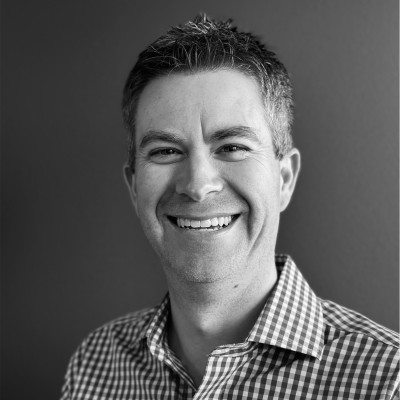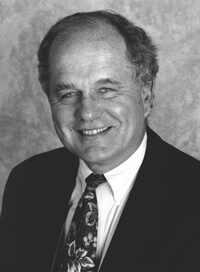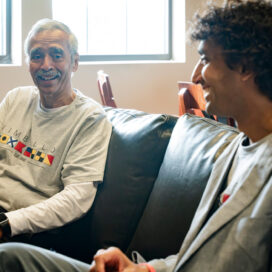As a kid growing up in the Bay Area, Bryan Quinn was the ultimate Fighting Irish fan. He estimates he watched the movie Rudy a million times. But when it came time to pick a college, he said no to the University of Notre Dame.
It was too darn cold.
His aversion to South Bend’s weather changed after his first startup company, Spy Media, got off to a strong start but ultimately petered out due to Quinn’s lack of business experience.

Bryan Quinn
“I was a confident twentysomething entrepreneur,” he says. “In 2004, I saw the trend of citizen journalism, so my partners and I built the first online marketplace for news photography to connect citizen journalists with local media companies. The company had some early traction across the United States and Europe. I thought more locations was a feature, but ultimately it stretched us too thin; we shut down in 2007. Spy Media could have been extremely successful, but I didn’t know how to build a company to scale.”
That experience influenced Quinn’s decision to go back to school for a Master of Business Administration (MBA). At the top of his list was Notre Dame. When his wife agreed to a year in the snow, he applied. “I bought a coat for my interview knowing it would be cold. My wife asked if I needed gloves. I said no, but she put a pair of her chenille gloves in my bag just in case. I got 10 feet from the rental car counter—it was three degrees in Chicago—before I had to put on the gloves. I wore them the entire visit to South Bend.”
Quinn’s year at Notre Dame brought more than an MBA. “I had heard about the Notre Dame network and thought it was a cliché; every school claims that. I was shocked to find out how powerful it actually is, and how willing alumni are to help fellow Domers. Through Notre Dame, I met Tim Connors, a venture capitalist. He gave me a list of startup companies in the Bay Area to look into for a job. One of them was Adify.”
Quinn interviewed with Adify, which was building digital advertising networks to enable clients like Disney, NBC, Time Warner, and Univision to increase their audience reach by integrating advertising inventory from websites with similar content. He hit it off with the Adify team, and it was back to California for the Quinns. He spent five years with Adify, during which time it was acquired by Cox Media Group for $300 million.
“I really grew with Adify, acquiring deep domain knowledge of media and advertising. By the time I left, I was running strategy and operations and had close relationships with colleagues that would serve me well later,” he says.
In 2012, Amazon approached him to lead a new digital advertising business focused on partnering with media companies. Quinn’s team built and patented technology to enable programmatic advertising with Amazon. From a team of two employees, Quinn successfully scaled the technology to thousands of directly integrated web, mobile app, connected TV, and audio publishers globally. By 2023, the business had grown to hundreds of people and was delivering billions of dollars in advertising.
Over his 11 years at Amazon, he founded Amazon Publisher Services and was responsible for the business’ P&L. As general manager, he led strategy and end-to-end functional areas including Product, Engineering, Business Development, Account Management, and Go-To-Market. His accomplishments included launching Amazon video advertising on Fire TV and Prime Video Channels, launching Amazon audio advertising on Alexa and Alexa-enabled interactive streaming TV shopping ads. He was also a member of Amazon’s senior leadership team for Sponsored Advertising.
Quinn was set with Amazon, but in late 2023, a former colleague from Adify, Glenn Fishback, came to him with an idea for a software-as-a-service (SaaS) startup with the power to transform content into shoppable journeys with an AI-driven retail media platform. Quinn was blown away.
“Watching Glenn’s demo gave me goosebumps. The opportunity was huge.”
With his family’s blessing, he left Amazon in the early days of January 2024 to co-found Shopsense.ai with Fishback. “I’m happiest when I’m building new technologies for customers. Building a company with Glenn was appealing for a couple of reasons: my domain experience with media companies pairs nicely with his deep retail experience. He’s an optimist who sees the glass as half-full, and I often see things through a glass half-empty lens. We have 15 years of trust between us; we balance each other out.”
The inspiration for Shopsense came from the realization that many shopping journeys begin with people watching television. For example, the hit show Yellowstone, a neo-western drama series starring Kevin Costner, sparked intense interest in Western culture and Western apparel.
“During the pandemic, people really got caught up in Yellowstone. Some even moved to Montana while others bought western apparel because they were influenced by what they saw. But here’s the problem: they liked Kevin Costner’s hat but didn’t know where to find it. When they finally did find and purchase a cowboy hat, Paramount Global didn’t participate in the commerce revenue despite inspiring the initial shopping journey. The idea behind Shopsense is to ‘shazamify’ TV to make shopping easier across fashion, home décor, sporting goods, and more. The concept applies to dramas, awards shows, lifestyle shows, and sporting events,” Quinn explains.
“All they have to do is visit the store’s URL or scan a QR code on their mobile device to connect to the broadcaster’s virtual store while watching TV to shop the products their favorite star is wearing or other products in the show. We also use AI to scan the internet for similar products that might be less expensive,” he adds.
The team began working together in early January of this year. A big advantage for Quinn was the past relationships he established while working at Amazon and Adify where he had worked with thousands of media companies around the world. From the beginning, Shopsense had plenty of potential customers.
In some respects, Shopsense stole a scene from the movie Field of Dreams: build it and they will come. Well before they had a functional product, they began courting potential customers with a slide deck. One of them was Paramount Global.
Originally, Quinn and his Shopsense AI co-founders hoped to have their first broadcaster live in July 2024. A meeting was lined up with Paramount in January. Fifteen minutes into Quinn’s presentation, Paramount executives said they wanted to partner with Shopsense, starting with the “CMT Music Awards” on April 7.
Even though the Shopsense product wasn’t yet live, Quinn said yes. “I was very grateful Paramount shared our vision and leaned in fast. It took many sleepless nights and grinding to make it happen, but the team did it. I have never moved so fast as I have with Shopsense. This win from Paramount, which is our biggest, really signaled to us that we had a viable, potentially blockbuster product”
A major business goal was how quickly Shopsense could launch a digital storefront, which is built around the items the broadcaster wants to merchandise in their store. Early on, it took weeks for Shopsense to build a curated storefront. Because of their technology, they can now launch a new storefront in less than a day. The storefronts are heavily reliant on AI and machine learning to scan Shopsense’s database of more than 500 million product SKUs from over 1,000 retailers to find what is featured in a program along with similar items.
Starting in April, Shopsense began working with the CBS daytime show “The Talk.” During the shows, the hosts let viewers know they can visit ShopTheTalkCBS.com or scan a QR code on the screen to instantly shop and purchase what the hosts were wearing as well as set décor from Macy’s and Target. The engagement was powerful. Within minutes of being shown on the show, items sold out.
By May, Shopsense had signed partnerships with two more powerful media partners, Televisa Univision and Tastemade. The Univision deal launched with the “Latin American Music Awards” on April 25. The live broadcast connected viewers with a curated collection of merchandise using QR codes and easy-to-remember URLs. Tastemade is using Shopsense for “Kitchen Glow Up”, a program hosted by professional chef-kitchen remodeler Ellen Marie Bennett. In this application, fans can go to Shop.Tastemade.com, stream past Kitchen Glow Up shows, and shop everything from paint and tile to appliances and cookware.
Quinn says he is surprised by Shopsense’s momentum. The company has several new media customers in negotiations and will soon launch new AI technology. It is looking to expand into podcasts and connect with YouTube influencers with a million or more followers. “The three most important words for startups are ‘ahead of plan,’ and we are definitely that!”
It does, however, take money to scale a company, even one with enviable traction like Shopsense. Funding startups has been a challenge for the last couple of years, but 2024 has been particularly tight. To fund Shopsense, the co-founders looked to friends and family and a small venture fund. Despite the tough funding environment, the company was able to raise a couple of million dollars, including $100,000 from former colleagues at Amazon which Quinn said was humbling. The Shopsense team is now considering another raise to double down on their momentum.
In early July, Shopsense announced a partnership with the PGA Tour on CBS. Simply by scanning a QR code on the screen during a golf tournament, fans can now purchase the same golf gear and apparel their favorite professional golfers have.
Quinn, a rabid sports fan, bursts out in a grin. “I would love to do The Masters!”
Wouldn’t we all?
Though still in the thick of his startup and buoyed by the quick success, Quinn is thoughtful as he offers this advice to others who dream of being entrepreneurs and launching companies.
“Understand your gaps and find people who complement your strengths and fill your gaps. Diversity of thought and experience is important. My domain knowledge is in streaming. My co-founder Glenn’s is retail. We disagree all the time, but our different experiences and perspectives fill each other’s gaps and here we are. The last six months have been exhausting but also the best six months of my career.”




